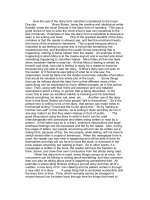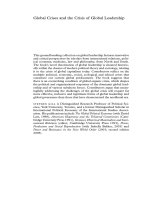Global fundraising how the world is changing the rules of philanthropy
Bạn đang xem bản rút gọn của tài liệu. Xem và tải ngay bản đầy đủ của tài liệu tại đây (3.75 MB, 397 trang )
Additional Praise for
Global Fundraising
“Penelope Cagney and Bernard Ross have done our sector a great service in
bringing together such a talented team of top philanthropy specialists and
non-profit experts to address the big issues covered by this book and give
us their insights. In times of unprecedented challenges there’s much excitement and optimism here, as well as sound guidance and helpful advice.
Anyone interested in fundraising and philanthropy internationally will find
this book a great investment.”
—Ken Burnett, author, Relationship
Fundraising and other books
“Global Fundraising, for an international fundraiser, is like have a Platinum
Card for your favourite airline and being flown business class around the
world gathering insights from some of the brightest and best fundraising
practitioners on this planet. Global Giving is a must have, must read, must
digest atlas for anyone taking a serious look at what is happening today in
the ever globalised world of fundraising and philanthropy.”
—Daryl Upsall, Chief Executive,
Daryl Upsall Consulting International
“This book is a long-overdue look at philanthropy globally. It will help
every fundraiser put their fundraising program into perspective.”
—Harvey McKinnon, President, Harvey McKinnon
Associates; author of 11 Questions Every Donor Asks
and the number one international bestseller
The Power of Giving
“Generosity always finds a way to help those in need. This extraordinary
book opens our eyes to experiences from people all over the world whose
remarkable vision and creativity are changing the way we look at fundraising. Without a doubt, a can´t miss read.”
—Isabella Navarro, former Development Director,
Universidad de Monterrey, Mexico
ffirs.indd i
14/02/13 10:53 AM
A Donor Bill of Rights
PHILANTHROPY is based on voluntary action for the common good. It is a tradition of
giving and sharing that is primary to the quality of life. To assure that philanthropy merits
the respect and trust of the general public, and that donors and prospective donors can have
full confidence in the not-for-profit organizations and causes they are asked to support, we
declare that all donors have these rights:
I.
VI.
To be informed of the organization’s mission, of
the way the organization intends to
use donated resources, and of its capacity to use
donations effectively for their intended purposes.
To be assured that information about
their donations is handled with respect and with
confidentiality to the extent provided by law.
II.
To be informed of the identity of those serving
on the organization’s governing board,
and to expect the board to exercise prudent judgement
in its stewardship responsibilities.
III.
To have access to the organization’s
most recent financial statements.
IV.
VIII.
To be informed whether those seeking
donations are volunteers, employees of the
organization or hired solicitors.
IX.
To be assured their gifts will be used for
the purposes for which they were given.
To have the opportunity for their
names to be deleted from mailing lists that
an organization may intend to share.
V.
X.
To receive appropriate
acknowledgement and recognition.
To feel free to ask questions when making
a donation and to receive prompt, truthful and
forthright answers.
D E V E L O P E D
B Y
Association for Healthcare Philanthropy (AHP)
Association of Fundraising Professionals (AFP)
Council for Advancement and Support of Education (CASE)
Giving Institute: Leading Consultants to Non-Profits
ffirs.indd ii
VII.
To expect that all relationships with
individuals representing organizations of interest
to the donor will be professional in nature.
E N D O R S E D
B Y
(in formation)
Independent Sector
National Catholic Development Conference (NCDC)
National Committee on Planned Giving (NCPG)
Council for Resource Development (CRD)
United Way of America
14/02/13 10:53 AM
ffirs.indd iii
14/02/13 10:53 AM
ffirs.indd iv
14/02/13 10:53 AM
Global Fundraising
ffirs.indd v
14/02/13 10:53 AM
ffirs.indd vii
14/02/13 10:53 AM
ffirs.indd viii
14/02/13 10:53 AM
Global Fundraising
How the World Is Changing
the Rules of Philanthropy
PENELOPE CAGNEY
BERNARD ROSS
John Wiley & Sons, Inc.
ffirs.indd ix
14/02/13 10:53 AM
Cover Design: Wendy Mount
Cover Image: © Andrew Johnson/Getty Images
Copyright © 2013 by Penelope Cagney, Bernard Ross. All rights reserved.
Published by John Wiley & Sons, Inc., Hoboken, New Jersey.
Published simultaneously in Canada.
No part of this publication may be reproduced, stored in a retrieval system, or transmitted in any
form or by any means, electronic, mechanical, photocopying, recording, scanning, or otherwise,
except as permitted under Section 107 or 108 of the 1976 United States Copyright Act, without
either the prior written permission of the Publisher, or authorization through payment of the
appropriate per-copy fee to the Copyright Clearance Center, Inc., 222 Rosewood Drive,
Danvers, MA 01923, (978) 750-8400, fax (978) 646-8600, or on the Web at www.copyright.com.
Requests to the Publisher for permission should be addressed to the Permissions Department,
John Wiley & Sons, Inc., 111 River Street, Hoboken, NJ 07030, (201) 748-6011,
fax (201) 748-6008, or online at />Limit of Liability/Disclaimer of Warranty: While the publisher and author have used their best efforts
in preparing this book, they make no representations or warranties with respect to the accuracy
or completeness of the contents of this book and specifically disclaim any implied warranties of
merchantability or fitness for a particular purpose. No warranty may be created or extended by sales
representatives or written sales materials. The advice and strategies contained herein may not be
suitable for your situation. You should consult with a professional where appropriate. Neither the
publisher nor author shall be liable for any loss of profit or any other commercial damages, including
but not limited to special, incidental, consequential, or other damages.
For general information on our other products and services or for technical support, please contact
our Customer Care Department within the United States at (800) 762-2974, outside the United
States at (317) 572-3993 or fax (317) 572-4002.
Wiley publishes in a variety of print and electronic formats and by print-on-demand. Some
material included with standard print versions of this book may not be included in e-books or in
print-on-demand. If this book refers to media such as a CD or DVD that is not included in the
version you purchased, you may download this material at . For more
information about Wiley products, visit www.wiley.com.
Library of Congress Cataloging-in-Publication Data:
Cagney, Penelope, 1956Global fundraising: how the world is changing the rules of philanthropy / Penelope Cagney and
Bernard Ross.
pages cm.—(The AFP/Wiley fund development series)
Includes index.
ISBN 978-1-118-370 70-4 (cloth); ISBN 978-1-118-41726-3 (ebk);
ISBN 978-1-118-42052-2 (ebk); ISBN 978-1-118-57017-3 (ebk)
1. Charities. 2. Globalization. I. Ross, Bernard, 1953- II. Title.
HV40.35.C34 2013
361.7—dc23
2012041910
Printed in the United States of America
10 9 8 7 6 5 4 3 2 1
ffirs.indd x
14/02/13 10:53 AM
Penelope Cagney dedicates this book to Nathan Newman,
for all of his support and encouragement.
Bernard Ross dedicates this book to George Smith, a wonderful
friend and guide to many nonprofits worldwide—
his words were his gift to us all.
ffirs.indd xi
14/02/13 10:53 AM
Contents
Foreword
Andrew Watt, President and CEO, AFP International
xvii
Acknowledgments
xxi
CHAPTER
1
Introduction to Global Fundraising
Penelope Cagney and Bernard Ross
PART I
CHAPTER
CHAPTER
2
3
1
What This Book Is About
Who This Book Is For
About the Editors and Contributors
Seven Global Megatrends
This Book’s Setup
Our Global Fundraising Wiki
1
1
2
3
12
14
An Overview of Giving by Region
15
China
Lu Bo and Nan Fang
17
A Historic Review of Philanthropy in China
A Panorama of China’s Nonprofit Sector
Framework for Nonprofit Sector
Current Fundraising Trends in China’s Nonprofit Sector
Fundraising Practices in China
In Summary
17
21
25
32
37
40
Japan
Masataka Uo
43
Japan: Overview of an Island Nation
Philanthropy and Other Support
Giving Practices
Fundraising Practices
Challenges and Innovation
In Summary
44
48
50
52
56
58
xiii
ftoc.indd xiii
14/02/13 11:53 AM
xiv
CONTENTS
CHAPTER
CHAPTER
CHAPTER
CHAPTER
CHAPTER
CHAPTER
ftoc.indd xiv
4
5
6
7
8
9
Latin America
Norma Galafassi
59
An Overview of Latin America
Income from Services
Giving by Individuals
Getting Money from the Bottom of the Pyramid
Institutional Givers: Governments, Foundations, and
Corporations
In Summary
59
66
68
71
80
85
Western Europe
Chris Carnie
89
The Nonprofit Sector in Western Europe
How Western Europe Is Changing the Rules of
Philanthropy
Where We Are and Where We Are Going
In Summary
90
96
104
107
North America
Penelope Cagney and Andrea MacManus,
with a case study by R. F. Shangraw Jr.
109
The United States of America
Canada
In Summary
109
128
134
Australia and New Zealand
Sean Triner
135
New Zealand
Australia
In Summary
137
137
151
Central and Eastern Europe
Matt Ide, Mair Bosworth, Anca Zaharia, with
an introduction by Chris Carnie
153
The Legal Grounds for Philanthropy
Fundraising in Central and Eastern Europe
Russia by Matt Ide and Mair Bosworth
Romania by Anca Zaharia
In Summary
154
155
156
174
177
Africa
Mike Muchilwa
179
Giving to NGOs in Africa
Giving for Religious Purposes
179
181
14/02/13 11:53 AM
CONTENTS
The Lack of Information on African
Philanthropy
Philanthropy and Other Support
Africa’s NGOs
Fair Trade and Social Enterprise in Africa
A Focus on Two Countries
In Summary
CHAPTER 10
CHAPTER
CHAPTER
11
12
PART II
CHAPTER
ftoc.indd xv
13
xv
182
184
187
188
189
221
Middle East and North Africa (MENA)
Tariq H. Cheema
223
The Current Landscape
Historical Context
Faith-Based Giving
The Paradigm Shift
The Mohammed bin Rashid Al Maktoum
Foundation
The Arab Foundations Forum
The World Congress of Muslim Philanthropists
In Summary
225
227
228
231
232
233
234
236
Asia
YoungWoo Choi and Usha Menon, with an
Introduction by Bernard Ross
239
Korea by YoungWoo Choi
Singapore by Usha Menon
In Summary
242
255
265
India
Usha Menon and Anup Tiwari
267
The Demographics of India
The Nonprofit Sector in India
In Summary
267
269
288
Overall Topics in Giving
291
Major Donors
Angela Cluff and Paula Guillet de Monthoux
293
Global Wealth
Where Are the Rich People?
Who Gives?
How Do NGOs and INGOs Go About It?
The Rich Will Save Us All—Philanthrocapitalism
In Summary
293
294
296
300
306
313
14/02/13 11:53 AM
xvi
CONTENTS
CHAPTER
CHAPTER
CHAPTER
14
15
16
Globarity—The Impact of Social Media
on Global Solidarity
Marcelo Iñarra Iraegui and Ashley Baldwin
315
The “We” without Borders
The Individual as King of the Crowd Empire: Is
Crowdfunding a Threat to NGOs or an Opportunity?
No More Sweeping Things under the Rug
The Social Speed of Light
Transcending Space: Connecting the Global
Community
In Summary
317
330
338
Innovation—The Only Competitive Advantage
Bernard Ross with research from Sudeshna Mukherjee
341
Why Is Innovation So Important?
Who Is Innovative?
How Do Charities Become Innovative?
How to Improve Innovation?
In Summary
342
343
346
353
355
The Charity Giants
Rebecca Mauger
357
Market Drivers
Competitive Drivers
Cost Drivers
Government Drivers
Common Themes from the Case Studies in
This Chapter
In Summary
359
359
360
360
About the Editors
About the Contributors
Index
ftoc.indd xvi
320
323
327
368
370
373
375
383
14/02/13 11:53 AM
Foreword
ANDREW WATT, PRESIDENT AND CEO,
AFP INTERNATIONAL
W
e’re inclined to talk as if globalization is a recent phenomenon.
That the links we see today, from culture to culture, in global
business and entrepreneurship, are something new.
Take a step back from what we read about a flat world for one
moment and remember the trade routes from east to west, developing commercial links between China and Rome and all the countries
in between, beginning in the pre-Christian era. Think of the way in
which the influences of religion, their cultures, science and learning,
from Islam, Buddhism, and Christianity, spread along those same trade
routes.
Consider the origins of many of the great corporations of the
twenty-first century in the global industrialization of the nineteenth—
manufacturing, engineering, the exploitation of mineral resources and
the operational infrastructure necessary to underpin them—we are not
seeing any radical shift in approach to maximizing resources and benefits today.
The differences are differences of scale and resource. New emerging
powerhouses of wealth in China, India, and Brazil—and many others besides; a generation of entrepreneurs the like of which has not
been seen in more than a hundred years; population growth on an
exponential scale and an equivalent growth in social need; technologysupporting connections at the click of a button; technology-supporting
trades in a millionth of a second; technology-supporting lightning
reactions, both good and bad.
xvii
flast.indd xvii
12/02/13 2:46 PM
xviii
FOREWORD
For all the progress, all the growth, the problems that we faced in
the nineteenth century of social inclusion, health, education, and political engagement are with us still. Exponential growth has not supported
stability in our environment. We have seldom lived in more volatile
times, economically or politically and, if ever there was such a thing as
a social compact, surely governments are tearing it up as we speak?
There has never been a greater need for the impact that our community, the civil society, can bring. But we have terrifying responsibilities to ensure that our impact is a beneficial one. By its nature,
civil society is unstructured, informal. Flexibility and speed of reaction
are some of our strengths. But lack of structure, lack of a consistent
message and a consistent approach means that our impact is far smaller
than it could or should be.
We are responsible, not just for the impact of our own organizations, but for ensuring that our collective impact far outweighs the
sum of its parts. We are responsible for working with partners beyond
the boundaries of the NGO community—in truth, for creating and
shaping a civil society inclusive of governments, the corporate sector,
and giving expression to the public voice. We are the enablers—the
link that binds these disparate communities together. And we have a
responsibility to shape that environment to secure change and the growth
of a just and fair society for all.
It’s easy to forget, as we go about our daily lives, that there are
essential building blocks that we have to develop.
We have to ensure that there is an enabling environment to support the work we do. Like it or not, without the partnership of
government in the form of a clear, consistent, and equitable regulatory environment, we cannot begin to achieve a unified and focused
community. Look to those arenas where such a thing has yet to exist.
In some instances, a morass of inconsistent and diverse regulation,
enforced by multiple agencies, ensures chaos and inhibits engagement
from those who want to support us most. In others, the lack of clear
regulation allows governments to act in an entirely arbitrary fashion,
following political objectives of the moment with little or no concern
for the impact on society that follows in the wake of their actions.
We can drive professionalism, we can drive awareness of good and
bad practice, but without the framework of regulation and the partnership of government, we have a much reduced chance of achieving
flast.indd xviii
12/02/13 2:46 PM
FOREWORD
xix
the understanding, support, and partnership of the communities in
which we live.
Education, at the professional level through training and the
resources to be found in books like this, yes, but also education of that
greatest of our partners, our public. We have signally failed, over many
years, to stand up and engage on the issue of “This is who we are;
this is the impact that, with you, we achieve; and this is what it takes
to secure that impact.” Communication, engagement, and investment.
We have failed again and again in this and yet we still pretend to be
surprised at the lack of trust that is so frequently expressed in us and
our work. We appear to have no understanding that it is a case of “if
not us, then who?” Each of us has the responsibility of making those
connections, standing up for our cause, and shouting how we have to
support it.
It’s for that reason that I am so glad to see the publication of this
book, edited by Penelope Cagney and Bernard Ross.
The themes of the book address the strategic issues—infrastructure,
strategy, regulation, and impact—in our rapidly changing and global
environment. It also addresses the impact that our ever-increasing
battery of tools, knowledge, and understanding has had and how it is
being applied to best effect in many different environments around the
world.
We can access much of that information for ourselves—using those
self-same tools, but I would question whether we are able to interpret it effectively for ourselves. Penelope and Bernard have brought
together a group of experts better placed than any others to help us
with that interpretation and to highlight the resources that are available
to us. Better yet, to highlight experiences from around the globe that
we can draw on for inspiration.
More than anything else, this book highlights for me the collective
strength that we have as fundraisers—a single community around the
globe. We are a community dedicated to ensuring change, to ensuring impact. If there is one thing that we should take away with us,
it is that, in the words of Desmond Tutu, speaking to fundraisers in
Baltimore in 2010, “This is a noble profession. Yours is a noble calling.”
Remember those words as you read this book and think about what
they mean. Our community is more than a profession—we are the
very heart of a movement for change.
flast.indd xix
12/02/13 2:46 PM
Acknowledgments
T
he editors would like to thank the AFP Book Advisory Committee members for their recognition of the rapidly changing
world of fundraising and their initiative and foresight in undertaking
publication of this book. We would also like to thank our John Wiley
& Sons editors, Susan McDermott, Jennifer MacDonald, and Donna
Martone, for their wise guidance in this undertaking. We are also
grateful to all of the authors who generously contributed their insight
and knowledge of philanthropy.
A special thanks from Bernard Ross to his =mc colleagues Clare
Segal, Angela Cluff, and Paula Guillet de Monthoux for their help,
encouragement, and occasional glasses of wine.
P.C.
B.R.
xxi
flast.indd xxi
12/02/13 2:46 PM
CHAPTER
1
Introduction to Global Fundraising
PENELOPE CAGNEY AND BERNARD ROSS
E
diting this book has been a humbling and exciting experience; humbling because, as two experienced—and supposedly internationally
savvy—fundraisers, we were constantly impressed at the extraordinary
achievements in fundraising happening outside the North American/
European bubble; and exciting because many of those developments
seemed to offer innovation or developments that have implications for
European and U.S. fundraisers. Just as the economic balance is changing
in the world, so the balance in fundraising may be changing.
W HAT T HIS B OOK I S A BOUT
This book is about global developments in philanthropy that are rocking the fundraising world and shattering conceptions about where philanthropy is strong and where fundraising innovation and creativity
exist. This book presents successes from India, Brazil, Russia, Australia,
Japan, and many other countries that inspire fundraisers. The book is
also intended to enlighten readers about specific areas of fundraising
important to the new global order—technology, innovation, and major
donors. It is also about truly global nongovernmental organizations
(NGOs)—the charity giants—that in relative scale are like the behemoth
Jupiter is in relationship to the other planets of the solar system.
W HO T HIS B OOK I S F OR
First and foremost, this book is for fundraisers, everywhere. It is also
for nonprofit CEOs who are considering the philanthropic potential
Global Fundraising: How the W orld Is Changing the Rules of Philanthropy
Penelope Cagney and Bernard Ross
© 2013 Penelope Cagney, Bernard Ross. Published 2013 by John Wiley & Sons, Inc.
c01.indd 1
1
11/02/13 11:26 AM
2
GLOBAL FUNDRAISING
outside of their own country’s borders. It is for other nonprofit professionals who work hand in hand with fundraisers and must understand these new global developments to most effectively carry out their
own work. Those involved with grant-making and other philanthropy
will learn from profiles of exemplary yet little-known international
philanthropists and about general developments in the nonprofit sector worldwide. The book is for those who provide essential infrastructure for the sector—the associations, regulatory bodies, and resource
organizations. Finally, this book is designed to open the eyes of anyone
who still thinks that fundraising and philanthropy are the prerogative of
North Americans and Europeans alone.
A BOUT THE E DITORS
C ONTRIBUTORS
AND
Editor Bernard Ross is recognized around the world as one of the few
whose fundraising, training, and management consulting expertise and
experience really spans the globe. One of his company’s (5mc) specialties is meeting the unique needs of international nongovernmental
organizations (INGOs). He is a regular presenter at fundraising conferences around the world including the Resource Alliance’s International
Fundraising Congress (IFC) and AFP International’s annual convening.
Editor Penelope Cagney has more than two decades of fundraising
consulting experience on three continents. Early in her career she recognized the growing influence of globalization on the nonprofit sector. After graduate study of the growth of private sector funding in
Great Britain, she cofounded a consulting firm there. It was then that
the editors first met and had their first literary collaboration on a book
about nonprofit management.
The contributors to this book are top professionals from around the
world whose achievements would be recognized anywhere. Most of
them are fundraising practitioners and consultants who have helped
advance the work of many of the most significant NGOs on earth. All
of them have been chosen not only for their success in the field, but
also for their understanding, insight, and contribution to the development of philanthropy in their own region.
c01.indd 2
11/02/13 11:26 AM
INTRODUCTION TO GLOBAL FUNDRAISING
3
S EVEN G LOBAL M EGATRENDS
There are some megatrends we spotted while reviewing the inputs
from the skilled and experienced contributors featured in this book.
As you read this book we’d be glad to know if you pick up on the
same broad issues and if they represent your view on the big trends
that are happening. You may well look at the same data and think differently about it.
Trend 1: There Is a Continuing Growth of Great Wealth and
Some of It Is Being Diverted to Philanthropy
Great wealth is no longer confined to the developed world—but it is
still concentrated in a small number of countries. It is also concentrated
in the hands of a small number of people as global inequalities increase.
The inequalities exist in many nations—but they raise some significant
challenges in territories like those in the Gulf or nations like Russia
where there is a more limited commitment to transparency about how
wealth is acquired or distributed. For fundraisers the challenge may not
simply be securing funds but ensuring that the funds secured will fit
with the value and ethical base of their charity.
Regardless of the ethical challenges about who really owns the
money, or even how they got it, there is a growing interest among
nonprofits in major donors, with increasing numbers of domestic and
international NGOs making specialist appointments to improve their
potential. But this organizational issue in fundraising is not necessarily matched by donor interest in philanthropy. So although the Giving
Pledge has taken off in the United States, it has been less successful
in engaging the rich elsewhere. And Carlos Slim—one of the world’s
richest men—has publicly expressed his frustration at the poor performance of NGOs in addressing the challenges in his native Mexico.
Many philanthropists indeed are setting up their own operating agencies or looking for new ways to deliver change. This is a challenge to
NGOs that have believed that all philanthropy should be channeled
through them.
Even where NGOs are the preferred channel, the culture of philanthropy needs to take root and become more sophisticated to
c01.indd 3
11/02/13 11:26 AM
4
GLOBAL FUNDRAISING
enable fundraisers to do their work well. In parallel we need donors to
become more effective in how they invest. If not we may see more of
the dreadful if well-meaning philanthropic ineptitude of Madonna in
Malawi and Oprah Winfrey in South Africa.
Trend 2: Nonprofit Innovations, in Fundraising and
Elsewhere, Are No Longer Coming Just from the
United States or Europe
There are exciting and challenging innovations growing up in fundraising in India and China and Argentina and Kenya. These innovations are not simply technological, but may relate to recognition of
how different cultures can engage in fundraising and philanthropy. By
learning about these developments we may inform our own learning
on fundraising.
In Argentina, for example, there are extremely high levels of online
giving. This is partly a result of a poor postal system. But that lack of a
postal system has driven charities to be more creative and imaginative
in the way they engage with donors—moving to online engagement
on a scale only dreamed of elsewhere.
In Ethiopia we’re seeing some of the largest mass participation events
in the world, especially marathons but also telethons—creating simple
acquisition channels for charities to gain access to potential donors.
Hogar de Christo in Chile is a parish and faith-based charity that
relies on the world’s largest and possibly best-organized team of volunteers and door-to-door collections to deliver fundraising results. At
a time when many charities are struggling to engage volunteers, this
domestic NGO offers real insights into new ways of gathering and
aligning supporters.
In Thailand Cabbages and Condoms1 avoids donor-based fundraising and instead runs commercial businesses to raise cash for its social
projects. (And it does so as a conscious and successful choice.) Thanks
to its success as a socially engaged business it not only runs a chain of
restaurants and a holiday resort but it uses the significant profits generated to pay for education, HIV work, prison reform projects, and
many more.
1
c01.indd 4
www.cabbagesandcondoms.com.
11/02/13 11:26 AM
INTRODUCTION TO GLOBAL FUNDRAISING
5
We see the same phenomenon in Kenya where the Red Cross
Society, once financially dysfunctional, now successfully runs a chain
of hotels that provide income for its relief services.
All of these experiments contain important lessons for any fundraiser
anywhere in the world.
Trend 3: Indigenous NGOs/NPOs2 Continue to Grow
in Number throughout the World, But There Are Some
Leviathans Emerging
As the role of the state is challenged worldwide, charities, NPOs
(nonprofit organizations) and NGOs are growing in number and
increasingly taking on civil society roles in health, education, and
social service. So the Red Cross in Kenya has set up and runs a successful ambulance service where the government service is seen as
ineffective. This growth—for example, the number of NGOs in the
Philippines has grown by 50 percent in the past 10 years—is increasing pressure on fundraisers and fundraising to deliver more money for
more causes.
At the same time a small number of large INGOs—Save the
Children, UNICEF, World Vision, for example—have broken away
in growth terms to form a super league of agencies able to fundraise
and operate almost anywhere in the world. They have aggressive
market entry strategies, significant investment funds, and teams dedicated to setting up and sustaining fundraising domestic operations.
To many domestic NGOs these agencies can seem like Walmart or
McDonald’s—a form of unwelcome globalization.
These super league agencies can invest in developing new markets
and are aggressively doing so. Some markets—Brazil, South Korea,
India—represent the fundraising equivalent of BRICs. And just as
2
What is commonly nonprofits or not-for-profit in the nonprofit, independent, or
third sector in the United States, is called by many names in other parts of the
world; for instance CSOs (civil society organizations) reside in civil society. There
are sometimes subtle differences in meaning and application of these terms that
will be explained in subsequent chapters of this book. For our purposes in this
chapter, we have grouped them under two types—NPOs and NGOs.
c01.indd 5
11/02/13 11:26 AM
6
GLOBAL FUNDRAISING
businesses are flocking to BRICs, so INGOs are flocking to these
high-growth philanthropic markets.
Most of these agencies are European or North American in origin
and act in many ways like commercial multinationals. Surprisingly,
perhaps, there are still only early signs of a developing world agency
growing to global INGO status. Early candidates like Asia’s BRAC
and Grameen have grown and work in a number of countries. But
both may never really grow to global status as they suffer under significant political pressure as result of their success and growth.
Trend 4: There Is Considerable Debate Worldwide about
the Role of Philanthropy and the Role of the State
There is certainly a growth in adoption of the capitalist/free-market
ideology worldwide generally—despite the recent global financial crisis
and the challenges offered by the Occupy movement and other critics.
Philanthropy in some areas is a companion ideology to free-market
capitalism. An increased role for fundraising is being accelerated by the
global financial crisis—philanthropy is being asked to do more as governments have reduced funds and so seek to do less.
As noted earlier, specifically there is a perceived growing role for
wealthy donors. This approach is shared in the book Philanthrocapitalism
by Matthew Bishop. It can be summarized as “a new approach to solving social problems based on innovative partnerships between business,
nonprofits, and government.”3 In practice the partnership seeks to draw
in corporations and wealthy individuals to what has historically been a
governmental space in many countries.
But it’s important to stress that not everyone agrees with this
growth in the role of philanthropy in addressing social challenges. The
Gates/Buffett Giving Pledge has not played well in some European
and Eastern nations where some millionaires have seen the pledge as
potentially undermining the “proper” role of the state in education, in
health, and in social security. In this case they may see the proper role
for wealthy individuals’ philanthropy as more focused in other directions like culture, medical research, and overseas aid.
The growth of philanthropy is also tied to democracy and to the
promotion of civil society, home to NPOs and NGOs.
3
c01.indd 6
www.philanthrocapitalism.net/about/synopsis/.
11/02/13 11:26 AM
INTRODUCTION TO GLOBAL FUNDRAISING
7
Civil society: The arena, outside of the family, the state, and the market,
which is created by individual and collective actions, organizations, and
institutions to advance shared interests.
Civil society encompasses civil society organizations (CSOs) and the
actions of less formalized groups and individuals. Organized civil society
refers to the independent, nonstate, and nonprivate sector associations and
organizations that have some form of structure and formal rules of operating, together with the networks, infrastructure, and resources they utilize.4
This linkage leads to a troubling trend—as in Ethiopia, Rwanda,
Russia, and elsewhere—where “anti-NGO” legislation is currently
pending or recently passed at the time of this writing. Where NGOs
are not banned outright, defunding through regulation is practiced in
many quasi-democracies. There are about four dozen countries where
civil society has been threatened over the past few years.5 Venezuela
has a new law, not yet in force at the time of this writing, putting
NGOs under permanent surveillance by the state while Zimbabwe
simply suspended many of them entirely.6
This trend appears even in parts of the world where new democracies have been formed. After the Arab Spring uprisings, a crackdown
on U.S.-funded pro-democracy groups in Egypt and a bill before parliament that would further restrict nongovernmental organizations
inhibited development work and activism. The move against NGOs
had been accompanied by personal attacks, threats, and intimidation of
activists, particularly women.7
This is a troubling trend because NGOs by and large seek to work
alongside governments and business. But they need a license to do so.
4
This definition is from the CIVICUS Civil Society Index project at http://
socs.civicus.org.
5
www.ipsnew.net/2012/08/civil-society-squeezed-on-all-sides/.
6
www.reuters.com/article/2012/04/25/us-egypt-unun-idUSBRE83O18J
20120425.
7
c01.indd 7
Ibid.
11/02/13 11:26 AM









